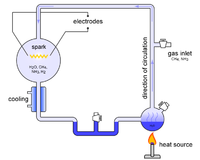
Photo from wikipedia
The first principle plane wave pseudo-potential method based on density functional theory system is used to calculate and simulate the geometric structure, density of states and optical properties of intrinsic… Click to show full abstract
The first principle plane wave pseudo-potential method based on density functional theory system is used to calculate and simulate the geometric structure, density of states and optical properties of intrinsic VC materials. And we further studied the adsorption performance of small gas molecules (CH4, CO, H2O, H2S) on the surface of VC(001). The most stable adsorption geometry of CH4, CO, H2O and H2S on the intrinsic VC(001) was determined, and the electronic structure and differential charge were calculated by the first principle method. The results show that the adsorption stability of the same molecule on the surface is related to the interaction position between the molecule and the surface after adsorption. According to the analysis of the differential charge density and the charge layout number, the charge layout number of the central atom C, O, S of the gas molecule increases after adsorption, and the adsorption strength of the gas molecule on the surface is CO > H2S > H2O > CH4. The H2S adsorbed on VC surface has the strongest adsorption energy (–1.442 eV) and more transfer charge (–0.12 e). The calculated dielectric function results shows that the existence of gases molecules inhibited the photon adsorbed on VC(001) surface. Our research provide a theoretical basis for further research on the gas sensing properties of material.
Journal Title: Physica Scripta
Year Published: 2021
Link to full text (if available)
Share on Social Media: Sign Up to like & get
recommendations!